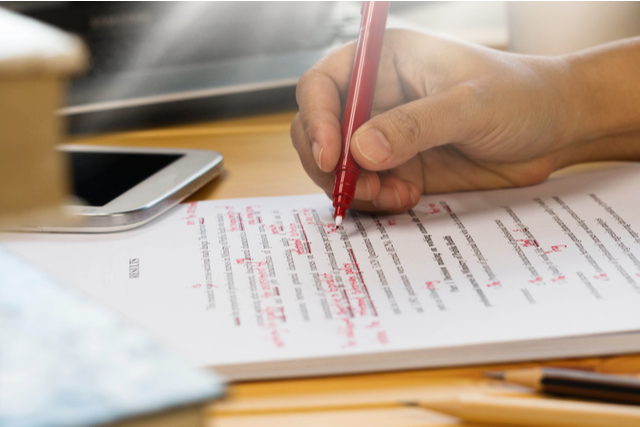
A few months into 2020, it’s worth a nostalgic glance back at how the publishing industry has changed in the past decade.
Just ten years ago, Penguin and Random House hadn’t yet merged, ProWritingAid wasn’t yet on hand to rescue all of our careless typos, publishing was limited to a lucky few authors, and editors were mythical beings who were locked within traditional publishing houses — beyond reach and sight.
We’ve come a long way since then, and authors have become increasingly entrepreneurial, putting together their own publishing teams for their self-published titles. But just because authors now have direct access to professional editors doesn’t mean it’s easy to know where to look, who to hire, or what to ask for.
This post will break down the three major steps of the editing process to help you discern what type of editing your book needs.
Developmental Editing
A developmental edit is the first stage of the editing process. As such, it will be the broadest edit of your manuscript. Depending on the book’s strengths and weaknesses, it will cover and identify all of the “big-picture” problems underlying your story, including:
- Pacing concerns
- Plot holes
- Thematic stumbles
- Overall structure
- Setting
- Characterization issues
As you can see, the development edit is pretty important in the grand scheme of things! And make no mistake: it’s not an easy part of the revision process. No author should go into it expecting to emerge completely unscathed. If you hire a good developmental editor, he or she will provide direct and honest feedback that will substantively change the story: subplots might be moved, chapters might be lopped off, and secondary characters might be eliminated. However painful as this might be, remember that it’s all for the good of the story—a book that undergoes developmental edits will generally come out leaner, tighter, and altogether better.
Because it’s so intensive and thorough, a developmental edit will be the most expensive kind of edit. (If you’re curious about how much such an edit might cut your wallet back, you can compare costs using this calculator.) If you’re on a budget, you can consider an editorial assessment as opposed to a full developmental edit. An editorial assessment is a thorough letter from an editor that summarizes the book’s big-picture concerns in a more compact format.
We also strongly recommend that you conduct a thorough self-edit before you hand your manuscript over to a professional developmental editor — which is when editing tools like ProWritingAid really come in handy. A professional developmental editor who isn't distracted by chaotic prose, spelling mistakes, and basic readability errors will be able to dig deeper into your story and provide greater value for money.
Speaking of which, note that a developmental editor will typically not dedicate their time to pointing out these more granular problems. That’s reserved for the next stage: the copy edit.
Copy Editing
So the dust has cleared from the developmental edit that you just put your story through. Now that your manuscript is structurally sound, what’s next?
The copy edit is the answer. This stage of the editing process is meant to “fine-tune” your story, so that it’s presentable to your future readers. Think of your manuscript as a precious stone. You unearthed the gem, and the developmental edit has made its shape and cut clear. Now it’s time to start polishing it into the diamond that the public will eventually see.
With that in mind, the copy edit will generally focus on the more microscopic parts of storytelling. Professional copy editors might, for instance, improve your sentence structure, eliminate purple prose, or point out places where your text can flow better. Here are some more things that will be on their radars:
- Repetitive sentences
- Instances of passive voice
- Vague language such as “it”
- Awkward dialogue
Copy editing is also sometimes known as line editing, which makes sense: a copy editor is in charge of going through your story and refining it, line by line. This exacting method provides greater opportunity to spot more specific mistakes in a story, such as incorrect facts, story anomalies, and potential inconsistencies in character descriptions. Using an editing tool like ProWritingAid can help you identify these weaker points in your writing and offer suggestions to fix it.
Of course, a copy edit will also start ridding your manuscript of pesky technical glitches. (This includes everything from grammatical mistakes to glaring typos—you probably know what we mean.) But this is not the stage that guarantees that your story is absolutely error-free—which leads us to the .proofreading
Proofreading
Congratulations! You’ve made it to the last step of the editing process: the proofread.
Often overlooked compared to its two siblings, proofreading nevertheless plays an integral role in the making of a story. To understand its importance, simply think about all of the times you caught an obvious gaffe in a book that you were reading. A single typo can make an audience raise their collective eyebrows and question the professionalism of the work. Multiple typos in a book may spell death to an author’s reputation among readers.
So the goal of this stage is simple: it’s meant to be a safety net that sweeps up any remaining mistakes in the manuscript. If any errors managed to slip through your notice until now, the proofread will catch ‘em all before your book goes to publication.
Try first using ProWritingAid, which can powerfully catch many of these problematic elements in your manuscript. You can turn to a proofreader only if you’d like the professional human touch. If your book passes a competent proofreader’s examination, then it’s safe to say that its text meets the standards of professionalism needed to thrive in the industry.
So What Kind of Edit Is Right for You?
The simple answer is: it depends.
A number of factors should be weighed when you make this decision. Some key questions that you might want to ask yourself as you go about it are:
- What stage is my book at? Judge your book and its blind spots carefully. Where will your story benefit the most from professional insight? Is your plot solid, or does it still read as though it was just spit out by a plot generator? Too many authors make the mistake of going for the copy edit when their books really need a developmental edit.
- What’s my budget? The cost of each edit is not the same—and neither is each professional editor. Determine your budget early on, so that you know what range is feasible for you.
- What’s my genre? Fiction books, for instance, possess different needs from non-fiction books.
- What’s my experience level? Is this your first book or your tenth book? If it’s the tenth and you’ve already got a trusted team of four beta readers around you, then you’ll likely need less professional help than if it's your debut.
For fiction authors in particular, we strongly recommend a developmental edit to ensure that the foundations of your story are rock-solid. If it sounds too expensive for you, you might want to look at its more budget-friendly cousin, the editorial assessment.
What isn’t in question is the impact that a professional edit can make to your work. If you’re self-publishing, this is a step that you just can’t afford to ignore: a proper edit (along with your book cover design) is what is going to separate the amateurs from the rest on bookshelves. And with a better understanding of what each kind of edit can do for your manuscript, you’ll be in a much more confident place to decide how to go about publishing the best possible version of your book.

